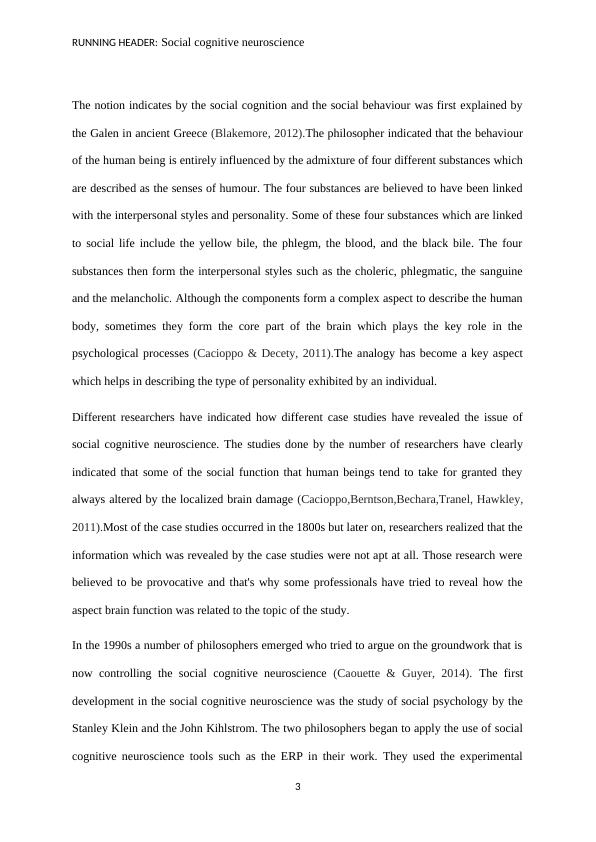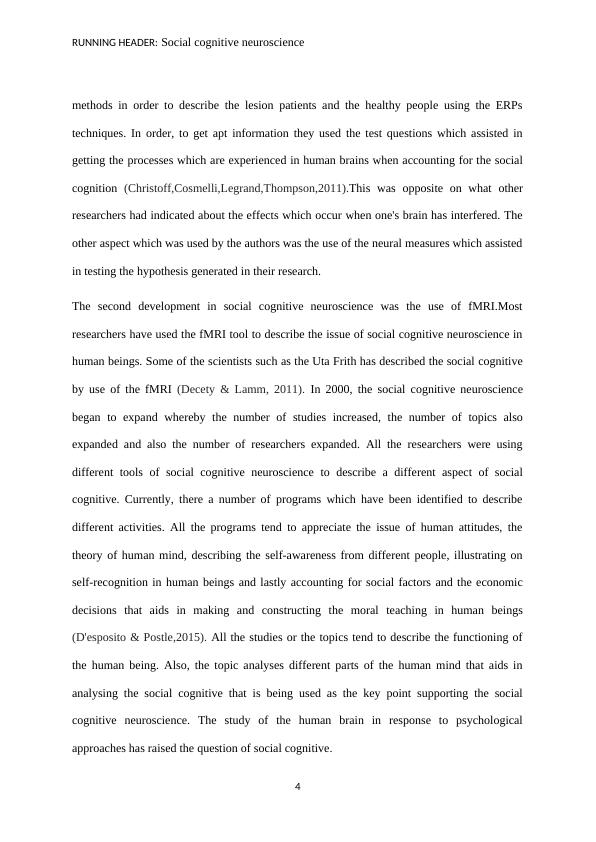Social Cognitive Neuroscience: Contributions of Language to Exposure Therapy
Added on 2023-04-19
20 Pages5870 Words360 Views
RUNNING HEADER: Social cognitive neuroscience
Social cognitive neuroscience
Name
Professor
Course
Date
1
Social cognitive neuroscience
Name
Professor
Course
Date
1

RUNNING HEADER: Social cognitive neuroscience
Topic: Feelings Into Words: Contributions of Language to Exposure Therapy
Introduction
Generally, social cognitive neuroscience is defined as the study of all processes which occur
in the human brain (Baron-Cohen, Tager-Flusberg, Lombardo, 2013). All the process in the
human brain help people to understand each other, be able to comprehend themselves and
also be in the position to navigate the available social life effectively and efficiently. The
social cognitive neuroscience tends to draw all the theories and recognitions such as the issue
of social cognition, anthropology, and political cognition. All the theories are obtained from
the social sciences which aid in revealing available phenomena's thus enhancing the field of
social cognitive neuroscience. There is the number of tools which are used to study the
subject of social cognitive neuroscience (Becker,Cropanzano,Sanfey,2011). The first tool is
the use of functional magnetic resonance imaging which is commonly known as the (fMRI)
and the second rule used to study social cognitive science is the use of positron emission
tomography which is commonly known as the (PET). There are other minor tools which aid
in studying the social cognitive neuroscience. These tools are transcranial magnetic
stimulation which is denoted as the (TMS), the event-related potentials commonly known as
the (ERP) and the last tools are neuropsychological lesion mechanism and the single cell
recording technique.
In the discussion, I have tried to discuss the topic given by showing the history of social
cognitive neuroscience. In order to account for the importance of the topic in social cognitive
neuroscience, I have indicated how different researchers have used the issue of social
cognitive neuroscience to explain social behaviour (Beeman & Chiarello, 2013).
Background of social cognitive neuroscience
2
Topic: Feelings Into Words: Contributions of Language to Exposure Therapy
Introduction
Generally, social cognitive neuroscience is defined as the study of all processes which occur
in the human brain (Baron-Cohen, Tager-Flusberg, Lombardo, 2013). All the process in the
human brain help people to understand each other, be able to comprehend themselves and
also be in the position to navigate the available social life effectively and efficiently. The
social cognitive neuroscience tends to draw all the theories and recognitions such as the issue
of social cognition, anthropology, and political cognition. All the theories are obtained from
the social sciences which aid in revealing available phenomena's thus enhancing the field of
social cognitive neuroscience. There is the number of tools which are used to study the
subject of social cognitive neuroscience (Becker,Cropanzano,Sanfey,2011). The first tool is
the use of functional magnetic resonance imaging which is commonly known as the (fMRI)
and the second rule used to study social cognitive science is the use of positron emission
tomography which is commonly known as the (PET). There are other minor tools which aid
in studying the social cognitive neuroscience. These tools are transcranial magnetic
stimulation which is denoted as the (TMS), the event-related potentials commonly known as
the (ERP) and the last tools are neuropsychological lesion mechanism and the single cell
recording technique.
In the discussion, I have tried to discuss the topic given by showing the history of social
cognitive neuroscience. In order to account for the importance of the topic in social cognitive
neuroscience, I have indicated how different researchers have used the issue of social
cognitive neuroscience to explain social behaviour (Beeman & Chiarello, 2013).
Background of social cognitive neuroscience
2

RUNNING HEADER: Social cognitive neuroscience
The notion indicates by the social cognition and the social behaviour was first explained by
the Galen in ancient Greece (Blakemore, 2012).The philosopher indicated that the behaviour
of the human being is entirely influenced by the admixture of four different substances which
are described as the senses of humour. The four substances are believed to have been linked
with the interpersonal styles and personality. Some of these four substances which are linked
to social life include the yellow bile, the phlegm, the blood, and the black bile. The four
substances then form the interpersonal styles such as the choleric, phlegmatic, the sanguine
and the melancholic. Although the components form a complex aspect to describe the human
body, sometimes they form the core part of the brain which plays the key role in the
psychological processes (Cacioppo & Decety, 2011).The analogy has become a key aspect
which helps in describing the type of personality exhibited by an individual.
Different researchers have indicated how different case studies have revealed the issue of
social cognitive neuroscience. The studies done by the number of researchers have clearly
indicated that some of the social function that human beings tend to take for granted they
always altered by the localized brain damage (Cacioppo,Berntson,Bechara,Tranel, Hawkley,
2011).Most of the case studies occurred in the 1800s but later on, researchers realized that the
information which was revealed by the case studies were not apt at all. Those research were
believed to be provocative and that's why some professionals have tried to reveal how the
aspect brain function was related to the topic of the study.
In the 1990s a number of philosophers emerged who tried to argue on the groundwork that is
now controlling the social cognitive neuroscience (Caouette & Guyer, 2014). The first
development in the social cognitive neuroscience was the study of social psychology by the
Stanley Klein and the John Kihlstrom. The two philosophers began to apply the use of social
cognitive neuroscience tools such as the ERP in their work. They used the experimental
3
The notion indicates by the social cognition and the social behaviour was first explained by
the Galen in ancient Greece (Blakemore, 2012).The philosopher indicated that the behaviour
of the human being is entirely influenced by the admixture of four different substances which
are described as the senses of humour. The four substances are believed to have been linked
with the interpersonal styles and personality. Some of these four substances which are linked
to social life include the yellow bile, the phlegm, the blood, and the black bile. The four
substances then form the interpersonal styles such as the choleric, phlegmatic, the sanguine
and the melancholic. Although the components form a complex aspect to describe the human
body, sometimes they form the core part of the brain which plays the key role in the
psychological processes (Cacioppo & Decety, 2011).The analogy has become a key aspect
which helps in describing the type of personality exhibited by an individual.
Different researchers have indicated how different case studies have revealed the issue of
social cognitive neuroscience. The studies done by the number of researchers have clearly
indicated that some of the social function that human beings tend to take for granted they
always altered by the localized brain damage (Cacioppo,Berntson,Bechara,Tranel, Hawkley,
2011).Most of the case studies occurred in the 1800s but later on, researchers realized that the
information which was revealed by the case studies were not apt at all. Those research were
believed to be provocative and that's why some professionals have tried to reveal how the
aspect brain function was related to the topic of the study.
In the 1990s a number of philosophers emerged who tried to argue on the groundwork that is
now controlling the social cognitive neuroscience (Caouette & Guyer, 2014). The first
development in the social cognitive neuroscience was the study of social psychology by the
Stanley Klein and the John Kihlstrom. The two philosophers began to apply the use of social
cognitive neuroscience tools such as the ERP in their work. They used the experimental
3

RUNNING HEADER: Social cognitive neuroscience
methods in order to describe the lesion patients and the healthy people using the ERPs
techniques. In order, to get apt information they used the test questions which assisted in
getting the processes which are experienced in human brains when accounting for the social
cognition (Christoff,Cosmelli,Legrand,Thompson,2011).This was opposite on what other
researchers had indicated about the effects which occur when one's brain has interfered. The
other aspect which was used by the authors was the use of the neural measures which assisted
in testing the hypothesis generated in their research.
The second development in social cognitive neuroscience was the use of fMRI.Most
researchers have used the fMRI tool to describe the issue of social cognitive neuroscience in
human beings. Some of the scientists such as the Uta Frith has described the social cognitive
by use of the fMRI (Decety & Lamm, 2011). In 2000, the social cognitive neuroscience
began to expand whereby the number of studies increased, the number of topics also
expanded and also the number of researchers expanded. All the researchers were using
different tools of social cognitive neuroscience to describe a different aspect of social
cognitive. Currently, there a number of programs which have been identified to describe
different activities. All the programs tend to appreciate the issue of human attitudes, the
theory of human mind, describing the self-awareness from different people, illustrating on
self-recognition in human beings and lastly accounting for social factors and the economic
decisions that aids in making and constructing the moral teaching in human beings
(D'esposito & Postle,2015). All the studies or the topics tend to describe the functioning of
the human being. Also, the topic analyses different parts of the human mind that aids in
analysing the social cognitive that is being used as the key point supporting the social
cognitive neuroscience. The study of the human brain in response to psychological
approaches has raised the question of social cognitive.
4
methods in order to describe the lesion patients and the healthy people using the ERPs
techniques. In order, to get apt information they used the test questions which assisted in
getting the processes which are experienced in human brains when accounting for the social
cognition (Christoff,Cosmelli,Legrand,Thompson,2011).This was opposite on what other
researchers had indicated about the effects which occur when one's brain has interfered. The
other aspect which was used by the authors was the use of the neural measures which assisted
in testing the hypothesis generated in their research.
The second development in social cognitive neuroscience was the use of fMRI.Most
researchers have used the fMRI tool to describe the issue of social cognitive neuroscience in
human beings. Some of the scientists such as the Uta Frith has described the social cognitive
by use of the fMRI (Decety & Lamm, 2011). In 2000, the social cognitive neuroscience
began to expand whereby the number of studies increased, the number of topics also
expanded and also the number of researchers expanded. All the researchers were using
different tools of social cognitive neuroscience to describe a different aspect of social
cognitive. Currently, there a number of programs which have been identified to describe
different activities. All the programs tend to appreciate the issue of human attitudes, the
theory of human mind, describing the self-awareness from different people, illustrating on
self-recognition in human beings and lastly accounting for social factors and the economic
decisions that aids in making and constructing the moral teaching in human beings
(D'esposito & Postle,2015). All the studies or the topics tend to describe the functioning of
the human being. Also, the topic analyses different parts of the human mind that aids in
analysing the social cognitive that is being used as the key point supporting the social
cognitive neuroscience. The study of the human brain in response to psychological
approaches has raised the question of social cognitive.
4

End of preview
Want to access all the pages? Upload your documents or become a member.
Related Documents
Social Cognitive Neurosciencelg...
|21
|6475
|305
Introduction to Psychology Assignmentlg...
|10
|2237
|65
Psychological Perspectiveslg...
|2
|1170
|68
Problems in Leadership Assignmentlg...
|14
|4978
|92
Weekly Workbook Questions for PSY 30013 Assignment 1lg...
|17
|6653
|243
Critical Social Work Theorieslg...
|11
|2818
|50
